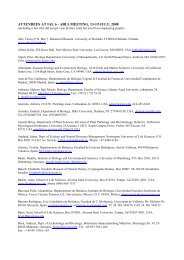international lichenological - International Association for Lichenology
international lichenological - International Association for Lichenology
international lichenological - International Association for Lichenology
Create successful ePaper yourself
Turn your PDF publications into a flip-book with our unique Google optimized e-Paper software.
10 INTERNATIONAL LICHENOLOGICAL NEWSLETTER 42 (1)<br />
New Literature<br />
BAYERISCHE AKADEMIE DER WISSENSCHAFTEN (ed.) (2009): Ökologische Rolle der<br />
Flechten (Rundgespräche der Kommission für Ökologie 36). – München: Verlag<br />
Dr. Friedrich Pfeil. 190 pages. Paperback. ISBN: 978-3-89937-096-6, ISSN 0938-<br />
5851 Price: 30,00 Euro.<br />
On 13 October 2008, the Bavarian Academy of Sciences invited 10 speakers and<br />
about 60 other guests <strong>for</strong> a round-table meeting on the Ecological Role of Lichens<br />
(see the report by L. Kappen in this issue). The volume under review has been<br />
published by the organizers Dr. A. Beck (Munich) and Prof. O. Lange (Würzburg),<br />
together with Dr. C. Deigele (Bavarian Academy). The range of the invited<br />
presentations attempted to highlight the various aspects of lichen ecology, starting<br />
with more general topics such as Lichens and their position in the system of fungi<br />
��������������������������Lichens: ecological aspects of the relationship between<br />
fungi and algae (R. Honegger). The following presentations are more specialised<br />
with Lichens in arctic, antarctic and alpine ecosystems (A. Green) and the Function<br />
of lichens in biological crusts (B. Büdel); then contributions related to the ecology<br />
of chemical compounds with Lichens and pollutants (M. Hauck) and the Ecological<br />
functions of lichen compounds (Y. Gauslaa); other topics covered are The role of<br />
lichens as food resources <strong>for</strong> animals, especially Lepidoptera. (H. Segerer), Ecology<br />
and physiology of lichens growing on bark (M. Lakatos, B. Hartard & C. Máguas)<br />
Lichens: Bioindicators of environmental changes� ���� �������������� ���� �������<br />
Lichens on monuments: Indicators and mediators between monument and nature<br />
conservation (R. & U. G. Drewello). All presentations were followed by discussions<br />
by participants, which are also published in this volume. Contributions are in German<br />
with short English summaries except the papers by Green and Gauslaa.<br />
Particular attention should be drawn to two papers presented by authors who are<br />
not lichen specialists. A. H. Segerer, a zoologist from the Munich Zoological State<br />
Collection, gives an overview of lichens as food, but from a lepidopterologist’s<br />
point of view explains that lichenivory is to be found in various unrelated groups<br />
����������������������������������������������������������������������������������������<br />
are still very scarce. Suprisingly the author uses the term lichenovory (instead of<br />
lichenivory), a spelling mistake which according to web searches has never been<br />
used be<strong>for</strong>e. In the discussion R. Honegger pointed out that invertebrates feeding<br />
on lichens could also be of importance <strong>for</strong> distributing lichens because living fungal<br />
and algal cells have been found in the excrements of these animals. R. & U. G.<br />
��������� �������� ���� �������� ��� ���� ��������� ���� ����������� ��� �������� ���� ����<br />
conservation of monuments. They clearly show that the ideally expected results of<br />
various cleaning methods cannot be achieved because it is impossible to completely<br />
remove all microbiological growth from stone surfaces despite the fact that every<br />
cleaning method is connected without some loss of the monument itself which is<br />
against the goal of monument protection. In their long-time studies on sandstone and<br />
limestone in northern Bavaria they found that lichen growth is actually protective of<br />
���������������������������������������������������������������������






